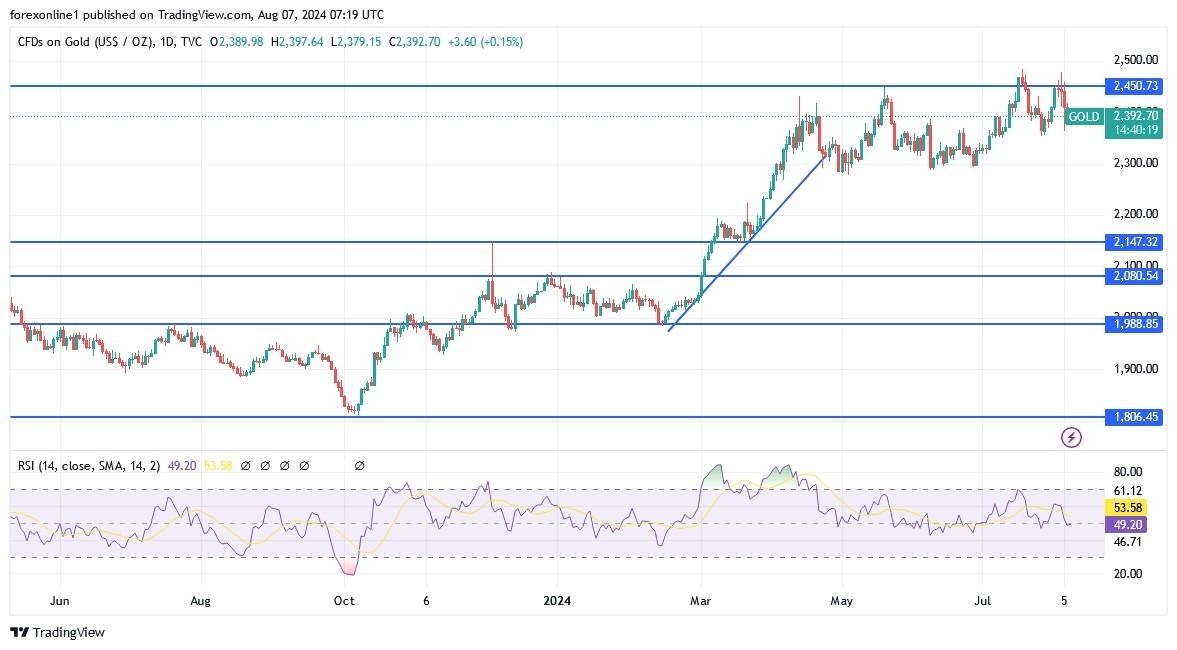- During yesterday's trading, the price of gold attempted to rebound upwards, gaining to the resistance level of $2418 per ounce.
- Furthermore, this recovery followed a decline of more than 1% in the previous session, with losses extending to the support level of $2365 per ounce.
- Currently, the price is stabilizing around $2390 per ounce at the beginning of trading today, Wednesday.
- The upward bias of the precious metal has remained intact, supported by its safe-haven appeal as markets have become more risk-averse.

In general, investors continued to assess the possibility of a recession in the United States of America after weak economic data and disappointing corporate earnings. Also, this led to increased expectations of multiple interest rate cuts by the Federal Reserve, as financial markets now estimate more than 100 basis points of total easing this year and expect a large rate cut of 50 basis points in September.
In addition, San Francisco Federal Reserve President Mary Daly said on Monday that she is open to cutting US interest rates if needed and stressed the need for a proactive approach to policy. Meanwhile, rising tensions in the Middle East continued to boost gold’s appeal as a safe haven.
According to gold trading platforms, gold futures declined at the beginning of the first full trading week of August, joining the sell-off in global markets. Global financial markets were reeling from a wide range of factors, from recession fears to the situation in Japan. Moreover, the good news for bulls is that the yellow metal is holding above $2400 per ounce. Lately, gold prices are coming off a 2% weekly gain and have risen 17.3% since the beginning of the year. In the same performance, silver prices, gold's sister commodity, struggled to stay above $27 per ounce. The white metal fell 3% last week, but silver prices are still up 13% so far this year.
According to trading, global financial markets witnessed a major defeat on Monday. Japan’s Nikkei average had its worst day since Black Friday in 1987. Asian indices, from South Korea’s Kospi to Thailand’s stock market, fell as much as 1,100 points. But it wasn’t just stocks that fell as energy commodities tumbled, cryptocurrencies crashed, and bond yields fell.
There were multiple reasons why this was happening.
The first was the U.S. jobs report in July. While the economy added 114,000 jobs last month, the unemployment rate rose to 4.3%, the highest level since October 2021. This is important because it triggers the Sahm rule, a recession indicator. Therefore, if the three-month moving average rises above 0.5%, it indicates that the country is in recession. Moreover, this method has been accurate in every recession except one since 1957.
The second reason is the Japanese yen trade. The yen trade involves borrowing Japanese yen at a low interest rate, converting it into another currency to invest in higher-yielding assets. Recently, the Bank of Japan recently raised interest rates by 0.15% and has indicated that it may increase the benchmark rate again next month. Finally, Warren Buffett and his Berkshire Hathaway sold half of their stake in Apple Inc. While the trade was marketed as a tax-related trade, investors see it as more than that.
As a result, market watchers are urging the Federal Reserve to use an emergency 50 basis point rate cut. Others are urging the central bank to implement half-point rate cuts at its September, November and December policy meetings.
Top Forex Brokers
While gold is falling, these factors could be bullish for the precious metal.
First, the US dollar index (DXY), a measure of the dollar against a basket of currencies, fell 0.61% to 102.58, from an opening of 103.21. The US dollar index has erased two-thirds of its gains since the beginning of the year in the space of a week. Obviously, a weaker dollar is good for dollar-denominated commodities because it makes them cheaper for foreign investors to buy.
Second, US Treasury yields are trending lower, although they have recouped most of their losses. The 10-year yield fell 3.1 basis points to 3.756%, while the 2-year yield fell 1.8 basis points to 3.852%. ultimately, Low interest rates are a boon for non-yielding bullion.
Gold Price Forecast and Analysis Today:
We still stick to my strategy of buying gold from every dip and currently the closest buying levels are $2355 and $2330 per ounce respectively. As for the bulls’ strong control, the psychological resistance at $2400 per ounce will remain the most important for the upward turn. Technically, gold prices will continue to benefit strongly from the increase in global geopolitical tensions and the shift in global central bank policies.
Ready to trade our Gold price forecast? We’ve made a list of the best Gold trading platforms worth trading with.
